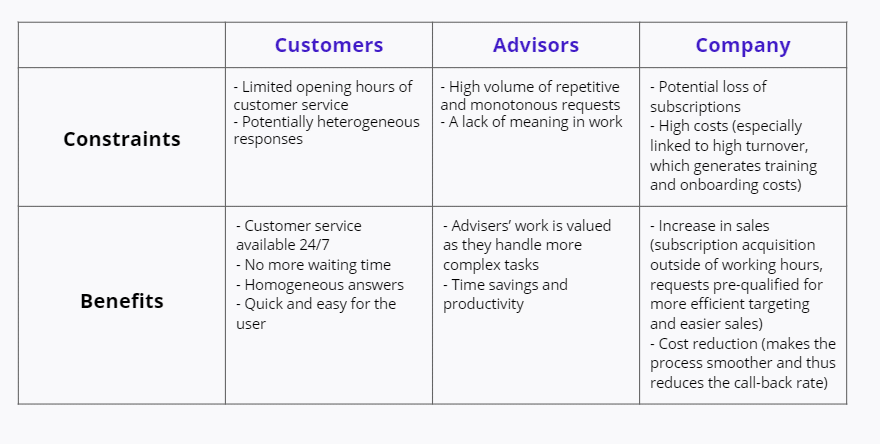
You may already have heard of callbots, new conversational robots that can be reached via telephone. Recently deployed in companies facing a high volume of calls (insurance, telephony, transport, e-commerce, hospitality…), they automatically answer customers or future customers’ questions and requests. They also qualify these requests and can transfer them to skilled advisers, as per the operational strategy in place.
These new bots replace Interactive Vocal Response (IVR) systems, where the user presses buttons on their keypad to reach the appropriate service: “To speak to a sales representative, please press 1. To reach our customer service, please press 2. To be connected to an agent, please press 3…”
Unlike IVRs, callbots dialogue with users in natural language. Read on to find out how.
How do they work?
Like chatbots, callbots function with a Natural Language Processing (NLP) algorithm. This algorithm makes it possible to render the conversation as natural as possible, thanks to the management of digressions, “small talk” and personalised responses, according to context and user history.
For a chatbot to become a callbot, two extra steps need to be added:
- Voice recognition (Speech-To-Text), the input which allows to capture the request and analyse it
- Voice synthesis (Text-To-Speech), the output which allows to deliver the requested information vocally to the user
Callbots are also connected to the company’s various web services (IS, CRM and ticketing platforms), to personalise the responses and trigger actions such as escalation to an adviser or sending a confirmation email/text message.
Extra work is required in comparison to setting up a chatbot; voice design! A voice-user interface is very different to a text one, and the bot needs to be adapted accordingly. Tone of voice, nuances, interruptions… In order for the conversation to be as natural as possible, the callbot must adapt to the user.
To find out more, read our article about conversational design.
Why should you implement a callbot?
By implementing a telephone conversational robot, you can meet the customer, adviser and company’s needs all at once:

And what about humans?
Like any other chatbot, callbots are not destined to replace advisers, but to work alongside them. The human role is essential, the bot acts as a complement to their work and therefore allows them to focus on more important tasks.
At the moment, whether textual or vocal, bots are unable to manage all the tasks performed by man. As soon as the conversation becomes more complex, the presence of an agent is essential to ensure a good customer experience.
And even if technologies are evolving rapidly and use cases multiplying, it is not in a company’s interest to let robots manage their entire customer relationship.
MACSF case study
MASCF, an insurance company for health professionals, implemented a callbot in December 2018 in order to extend the opening hours of its customer service and pre-qualify incoming requests. The aim? To improve the experience of (future) policy holders, increase sales and make the processing of requests smoother.
Thanks to the callbot, named Marion, if a user reports a claim in the evening or at night, they are automatically called back the next day to confirm, saving a considerable amount of time for both the insurer and policy holder. Users can also take out new car insurance via the callbot, effective immediately. At the end of the conversation, the bot sends the user confirmation by text message and integrates their request into the IS so that it can be processed by the correct management service.
During the very first month following the launch, Marion answered 2000 calls with an 89% intent recognition rate. The next steps will be to optimise the existing use cases, and to add new use cases to implement a permanent robot (working and non-working hours).
Last April, MACSF won the “Argus d’or” for its callbot, a prize rewarding the best innovation initiatives in the insurance industry.
If you would like to know more about our dydu callbots, please don’t hesitate to ask for a demo.






